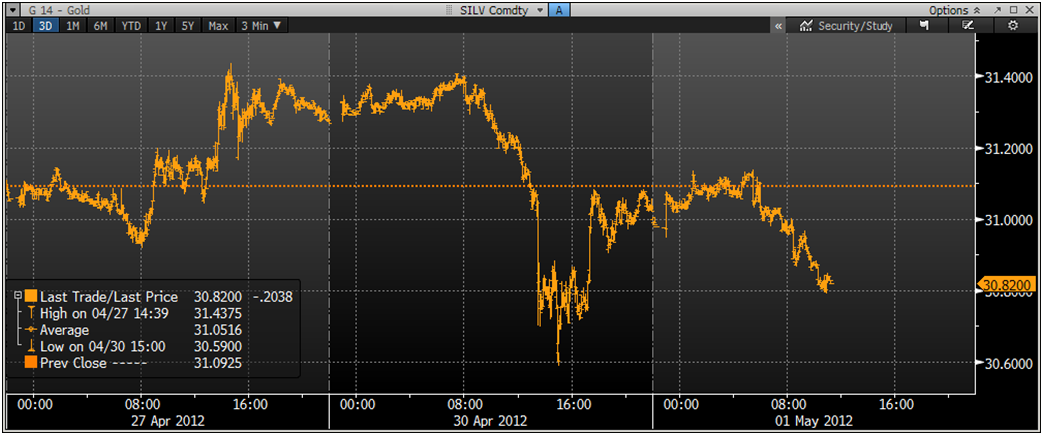Posted by Charleston Voice, 5.01.12
[excerpted from fxstreet]
The
gold market was briefly shaken by an unusually large early morning sell
order, which triggered a brief trading halt in gold futures and left
traders questioning whether the transaction was a mistake and the
motivation of the seller.
Gold
fell $14 in one minute despite no breaking financial and economic news
and despite no movement in the dollar, oil, equity or bond markets.
There
was only the insignificant personal income and spending numbers – which
came in slightly better than expected and could not justify such quick
falls.
CME
Group Inc's Comex division recorded an unusually large transaction of
7,500 gold futures during just one minute of trading. The sale took out
blocks of bids as large as 84 contracts in one fell swoop and cut prices
down $15 to $1,648.80 a troy ounce.
The sharp losses triggered a 10-second trading halt in June-delivery gold futures, CME told Dow Jones Newswires Tatyana Shumsky.
"The
market was given a short period to recalibrate and ... it was for 10
seconds," a CME spokesman said. "It only happened in gold futures, in
the June gold contract."
Gold
traders buzzed with speculation that the transaction was an input error
- a so-called "fat finger" trade. "Or a Gold Finger as it might be
known in the bullion market," traders at Citi joked in a note to
clients.
The
massive size of the transaction - 750,000 troy ounces worth more than
$1.24 billion – led to speculation that it was either a mistake by a
trader or that an entity wished to manipulate the market lower.
Such
large trades have frequently been seen at month and quarter beginning
and ends. Yesterday was the last trading day of the month. They have
also been seen when Ben Bernanke has been making important statements
regarding the dollar and the outlook for the US economy.
The
nature of the massive sell order, one of many seen in recent months,
suggested that the seller was not motivated by profit and may have had
other motives. Such large trades are rarely conducted amid very thin
trading volumes.
Trading
yesterday was expected to be quiet as market participants in China and
Japan were out on holiday and many European traders were preparing for
May Day holidays today.
"No
one who has the account size and the money to trade thousands of gold
contracts would do it in one transaction; that's just stupid," said one
trader.
Silver 3 Day Chart – (Bloomberg)
It
seems likely that the seller was either a large hedge fund or
institution as the collateral required to purchase 7,500 contracts is
high. The seller would have had to have deposited $ 75.9 million in cash
with a broker.
There
was a suggestion in the Reuters Global Gold Forum that the selling may
have been due to algorithm trading or computer driven.
The
trade could be as a result of the shift to electronic trading. Computer
trading systems are vulnerable to input errors, as they do not
‘question’ the order before executing the transaction.
By
contrast, when most order flow would pass through the Comex floor where
human traders processed the deals, potential errors stand higher
chances of being intercepted and there is a higher level of
transparency.
"You would definitely [verify a trade this big] before you executed it," said one Comex floor broker.
However,
the trade is unlikely to have been a keystroke error as silver also saw
substantial selling at the same time and similar price falls.
This
suggests that the seller wished to see gold and silver prices lower.
Some traders suggest that there may be High Frequency Trading (HFT)
programmes that can see where stop loss orders are placed and sell in
order to force stop loss selling – then buying back and thus making a
quick profit.
It
will further fuel allegations that certain Wall Street banks, either
alone or in conjunction with the Federal Reserve and US Treasury, are
intervening in and manipulating prices in the precious metal markets.
The
Gold Anti Trust Action Committee (GATA) and other knowledgeable market
participants have alleged that this is continuing to be done in order to
maintain faith in the US dollar and the US capital markets.

